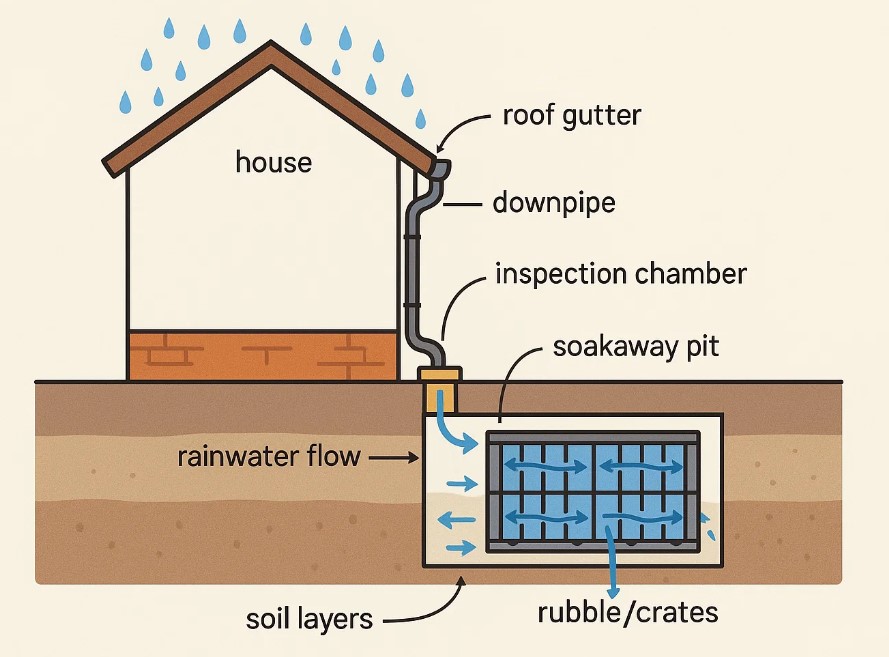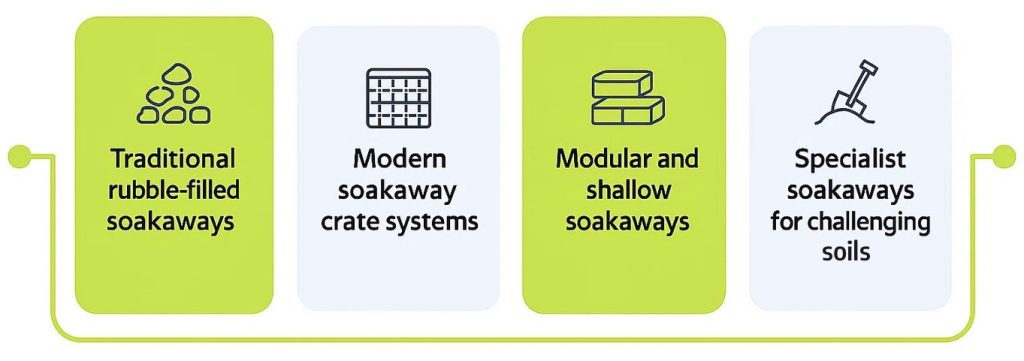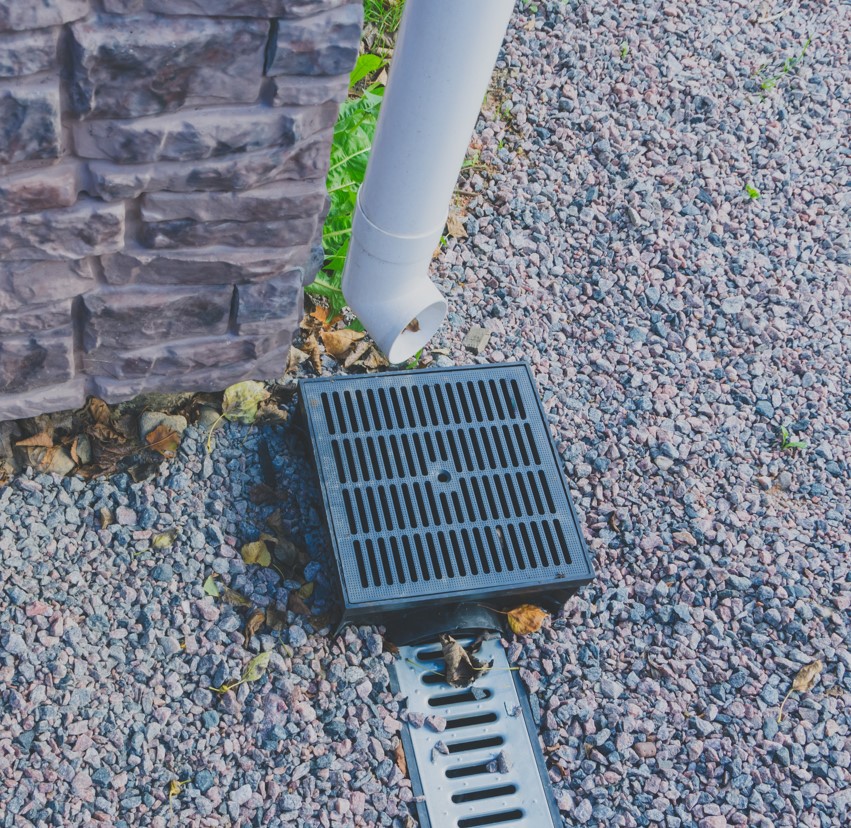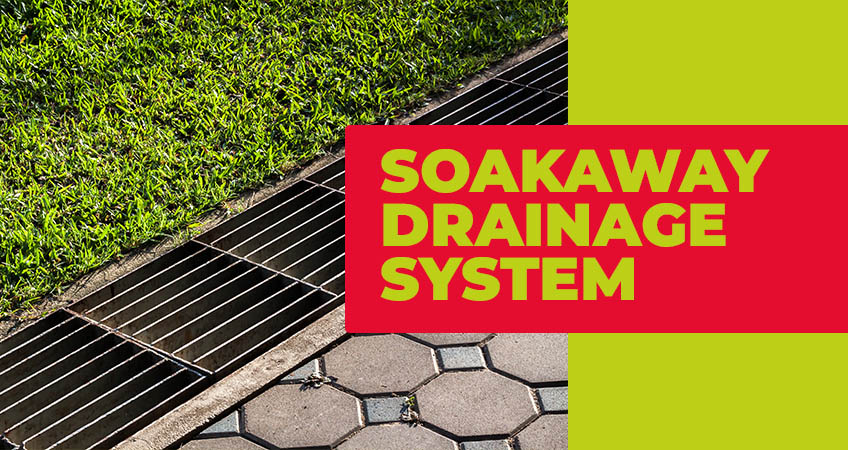If you’ve ever stood in your garden after heavy rain, watching water pool around your property like an unwelcome swimming pool, you’ve probably wondered if there’s a better way to manage all that excess water. Enter the humble soakaway drainage system—your garden’s answer to becoming a temporary lake every time the British weather decides to show off.
But what exactly is a soakaway system, and more importantly, do you actually need one? Whether you’re dealing with persistent puddles, worried about flooding, or simply want to give your property’s drainage a helping hand, understanding soakaway drainage could save you from future headaches (and soggy socks). A soakaway drainage system helps protect your house from flooding and water damage by safely dispersing excess rainwater away from your home’s foundations.
This guide will walk you through everything you need to know about soakaway systems, from how they work to whether your property could benefit from one. By the end, you’ll be armed with all the knowledge needed to make an informed decision about your drainage needs.
What is a soakaway drainage system?

A soakaway drainage system is essentially nature’s way of dealing with excess surface water, but with a helping hand from human engineering. Think of it as a giant underground sponge that collects rainwater and slowly releases it back into the surrounding soil.
The system consists of a large hole dug into the ground to a suitable depth, ensuring compliance with safety regulations and proper function. The correct depth is crucial for the soakaway to work efficiently and meet building standards.
Before installation, the hole must be cleared of tree roots and other debris to provide a stable base for the structure. The hole is then filled with either rubble or modern plastic crates that resemble oversized milk crates. Side fill and sand are used around the crates to stabilise the structure and support it over time.
After placing the crates, they are covered with soil or turf, and the soakaway is properly covered to prevent ground movement and blockages. This pit is then connected to your property’s guttering or surface water drains via rainwater pipes, using a pipe entry point to direct water into the soakaway. Holes in the crates or pipes allow water to flow into the soakaway structure, facilitating effective drainage.
It’s worth noting that soakaway systems are strictly for surface water only. Since 2015, regulations have changed, and soakaways can no longer be used for foul water or wastewater disposal. If you need to deal with sewage, you’ll need a proper drainage field connected to a sewage treatment plant, which requires permits from the Environment Agency.
The beauty of a soakaway drain lies in its simplicity. Rather than allowing surface water to overwhelm your main drainage system or pool around your property, it provides a controlled way for water to return to the natural water cycle.
Types of soakaway systems

When it comes to managing excess surface water and protecting your property from flooding, not all soakaway systems are created equal. The right solution for your home or garden depends on your soil type, available space, and the volume of water you need to drain.
Here’s a quick guide to the main types of soakaway systems and how they help water slowly drain into the surrounding soil.
Traditional rubble-filled soakaways
The classic approach, often found in older properties, involves digging a pit and filling it with coarse rubble or gravel. This creates gaps for surface water to collect and gradually seep into the soil. While simple and cost-effective, rubble-filled soakaways can become clogged with silt over time, reducing their ability to slowly drain excess surface water. They’re best suited to gardens with free-draining soil and moderate water flow.
Modern soakaway crate systems
Today’s most popular option is the soakaway crate system. These use strong, lightweight plastic crates stacked underground to create a large void for water storage. Wrapped in a geotextile membrane, they prevent soil and debris from entering while allowing water to escape into the surrounding soil. Soakaway crates are highly efficient, easy to install, and ideal for handling large volumes of rainwater, making them a top choice for new builds and properties with significant surface water drainage needs.
Modular and shallow soakaways
For properties with limited space or high water tables, modular or shallow soakaway systems offer a flexible solution. These systems use smaller, interconnected units that can be arranged to fit awkward spaces or installed at shallower depths. They’re particularly useful where deep digging isn’t possible, but you still need to manage excess surface water and reduce the risk of flooding.
Specialist soakaways for challenging soils
If your garden has heavy clay or poorly draining soil, standard soakaway systems may struggle to perform. In these cases, specialist solutions—such as larger crate systems, extended drainage fields, or engineered soil amendments—can help water slowly drain away and prevent pooling. A professional assessment is often needed to design a system that works with your specific soil conditions.
Each type of soakaway system is designed to help excess water drain away safely, protecting your property from waterlogging and reducing the risk of flooding. By choosing the right system for your soil and drainage needs, you can ensure that surface water is managed efficiently and sustainably, keeping your garden and home dry whatever the weather.
How does soakaway drainage work?

The mechanics of soakaway drainage are refreshingly straightforward. When rainwater hits your roof, it flows into gutters and downpipes before travelling through underground drainage pipes to reach your soakaway system.
The soakaway itself is constructed using specially designed plastic crates that create a void space underground. These crates are wrapped in a geotextile membrane—a fancy name for permeable fabric that allows water through whilst keeping debris out. This membrane is crucial as it prevents soil, leaves, and other materials from clogging up your system. Installing a silt trap can further protect the system from blockages by capturing silt and debris before they enter the soakaway.
As water enters the soakaway, it fills the void spaces within the crates. From there, it slowly infiltrates the surrounding soil through a process called percolation. The rate at which this happens depends on your soil type—sandy soils drain quickly, while clay soils take much longer. It is important to conduct a percolation test before installation to assess whether your soil is suitable for a soakaway and to ensure efficient drainage.
The gradual release of water serves several purposes. It prevents sudden surges of water entering the main drainage system during heavy rainfall, reduces the risk of localised flooding, and helps maintain natural groundwater levels. Essentially, your soakaway system acts as a buffer, managing the flow of surface water in a controlled and environmentally friendly manner.
When do you need a soakaway system?
Determining whether you need a soakaway system isn’t always immediately obvious, but there are several telltale signs that suggest your property could benefit from one.
Persistent surface water issues are the most obvious indicator. If you regularly find puddles forming on driveways, patios, or lawn areas after rainfall, a soakaway drain could provide the solution. Similarly, if water seems to hang around your property’s foundations or you’ve experienced any flooding issues, installing a soakaway system should definitely be on your radar.
Overwhelmed existing drainage is another key sign. If your current surface water drains struggle during heavy rainfall, leading to backups or slow drainage, a soakaway can help by diverting water away from the main system. This is particularly relevant for properties in areas prone to heavy rainfall or those with large roof areas that generate significant water runoff.
Planning requirements might also necessitate a soakaway installation. Many local authorities now require new developments or extensions to include sustainable drainage systems (SuDS) to manage surface water runoff. Regulations may also govern the discharge of surface water, requiring specific drainage solutions to ensure compliance and prevent environmental harm. If you’re planning building work, check whether soakaway drainage forms part of your planning conditions.
Environmental considerations shouldn’t be overlooked either. Properties in areas where surface water runoff could cause environmental issues downstream may benefit from soakaway systems to reduce their impact on local watercourses. In some cases, directing water to a watercourse or using a septic tank may be considered as alternatives, but both discharge options are subject to strict regulations and should be carefully evaluated.
However, not every property is suitable for soakaway drainage. Homes built on clay soils or in areas with high water tables may find that soakaways don’t function effectively. This is where professional assessment becomes invaluable.
Benefits of soakaway drainage
Installing a soakaway system brings numerous advantages that extend beyond simply managing excess water around your property.
Reduced flood risk
By providing an alternative route for surface water, soakaways significantly reduce the likelihood of localised flooding during heavy rainfall. A rainwater soakaway offers temporary storage for excess rainwater, gradually releasing it into the ground and helping to prevent waterlogging and flood risks. This protection extends to your property’s foundations, potentially saving thousands in structural repairs.
Cost-effectiveness
Compared to other drainage solutions, they’re relatively inexpensive to install and maintain. Once in place, they require minimal ongoing costs, making them a sound long-term investment for most properties.
Environmental benefits
Soakaways help maintain natural water cycles by allowing rainwater to return to groundwater rather than being diverted into sewerage systems. By preventing excess rainwater from overwhelming the sewer network, soakaways reduce pressure on local water treatment facilities and help maintain natural water table levels.
Reduced maintenance
While soakaways do require periodic inspection and occasional maintenance, they’re generally much less demanding than complex drainage networks or pumping systems.
Retrofit flexibility
Unlike some drainage solutions that require extensive modifications to existing infrastructure, soakaways can usually be installed with minimal impact on your daily routine.
Property value enhancement
Properties with well-managed drainage are more attractive to potential buyers and may command higher sale prices, particularly in areas prone to flooding issues.
How to maintain a soakaway system
Maintaining your soakaway drainage system isn’t complicated, but regular attention will ensure it continues functioning effectively for years to come.
Regular visual inspections should be part of your routine property maintenance. Check that the area around your soakaway remains clear of vegetation with extensive root systems, as these can interfere with the drainage process. Trees and large shrubs planted too close to soakaways can cause problems as their roots seek out water sources.
Keep inlet points clear by ensuring that guttering and downpipes feeding into your soakaway remain free from leaves, debris, and blockages. This is particularly important during autumn when falling leaves can quickly accumulate and cause problems.
Monitor drainage performance by observing how quickly surface water clears after rainfall. If you notice water taking longer to drain or pooling in areas that previously cleared quickly, this could indicate your soakaway needs attention.
Professional inspection should typically occur every few years, depending on your system’s usage and local conditions. A qualified drainage engineer can assess whether the soakaway is functioning correctly and identify any potential issues before they become major problems. Having access points built into the soakaway system allows for easier inspection, cleaning, and ongoing maintenance.
Expect eventual renewal as most soakaway systems require replacement approximately every decade, though this can vary significantly based on soil conditions, usage, and installation quality. Planning for this eventuality helps avoid emergency situations when systems fail unexpectedly.
FAQs
How long does a soakaway system last?
Most soakaway systems function effectively for 10-15 years before requiring renewal or replacement. However, lifespan varies depending on soil conditions, installation quality, and maintenance levels.
Can I install soakaway crates myself?
While it’s technically possible to install a basic soakaway system as a DIY project, professional installation ensures compliance with building regulations and optimal performance. Complex installations definitely require professional expertise.
What size rainwater soakaway do I need?
Soakaway sizing depends on roof area, local rainfall patterns, and soil percolation rates. Professional assessment is recommended to determine appropriate sizing for your specific circumstances.
How much does soakaway installation cost?
Costs vary significantly based on size, complexity, and location. Simple installations might cost a few hundred pounds, while larger or more complex systems can run into thousands. Getting multiple quotes helps establish realistic budgets.
Will a soakaway work in clay soil?
Clay soils have poor percolation rates, making soakaways less effective. Professional soil testing can determine whether your soil is suitable, and alternative solutions may be recommended for clay-heavy soils.
Do I need planning permission for a soakaway?
Most domestic soakaway installations fall under permitted development rights and don’t require planning permission. However, checking with your local authority is always advisable, particularly for larger systems.
Can soakaways freeze in winter?
Well-designed soakaway systems rarely freeze as they’re typically installed below the frost line. However, inlet pipes and surface connections may be vulnerable to freezing in severe weather.
Conclusion
Managing surface water effectively requires the right approach for your specific property and circumstances. While soakaway systems offer excellent solutions for many properties, determining whether they’re right for your situation requires professional assessment.
Need expert drainage advice?
At Any Drains Direct, our experienced drainage engineers can assess your property’s drainage needs and recommend the most appropriate solutions. Whether you’re dealing with persistent surface water issues, planning new construction, or simply want to improve your property’s flood resilience, we’re here to help.
Don’t let drainage problems dampen your enjoyment of your property. Contact Any Drains Direct today for expert advice, professional installation, and ongoing maintenance support. Our team provides free, no-obligation consultations to help you understand your options and make informed decisions about your drainage needs.
Get in touch with Any Drains Direct—because when it comes to drainage, getting it right the first time makes all the difference.
 01732 667 688
01732 667 688


